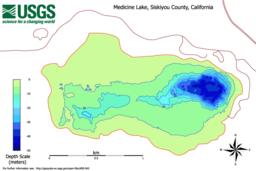Medicine Lake Volcano
| Medicine Lake Volcano | |
|---|---|
 Medicine Lake volcano as seen from Lava Beds National Monument | |
| Highest point | |
| Elevation | 7,921 ft (2,414 m) NAVD 88[1] |
| Coordinates | 41°36′39″N 121°33′13″W / 41.610956028°N 121.553635458°W[1] |
| Geography | |
| Location | Siskiyou County, California, U.S. |
| Parent range | Cascade Range[2] |
| Topo map | USGS Medicine Lake |
| Geology | |
| Age of rock | about 500,000 years[3] |
| Mountain type | Shield volcano |
| Volcanic arc | Cascade Volcanic Arc[2] |
| Last eruption | 1080 ± 25 years[4] |
| Medicine Lake | |
|---|---|
 The lake with Mount Shasta in the background | |
 Bathymetric map | |
| Location | California |
| Coordinates | 41°34′54″N 121°35′56″W / 41.58167°N 121.59889°W |
| Basin countries | United States |
| Max. length | 0.6 mi (1 km)[3] |
| Max. width | 1.2 mi (2 km)[3] |
| Surface area | 0.64 sq mi (1.65 km2)[5] |
| Average depth | 24.0 ft (7.3 m)[5] |
| Max. depth | 152 ft (46.4 m)[5] |
| Water volume | 470,000,000 cu ft (13,400,000 m3)[5] |
| Shore length1 | 20,384 ft (6,213 m)[5] |
| References | [3][5] |
| 1 Shore length is not a well-defined measure. | |
Medicine Lake Volcano is a large shield volcano in northeastern California about 30 mi (50 km) northeast of Mount Shasta. The volcano is located in a zone of east-west crustal extension east of the main axis of the Cascade Volcanic Arc and the Cascade Range. The 0.6 mi (1 km) thick shield is 22 mi (35 km) from east to west and 28 to 31 mi (45 to 50 km) from north to south, and covers more than 770 sq mi (2,000 km2). The underlying rock has downwarped by 0.3 mi (0.5 km) under the center of the volcano. The volcano is primarily composed of basalt and basaltic andesite lava flows, and has a 4.3 by 7.5 mi (7 by 12 km) caldera at the center.
The Medicine Lake shield rises about 3,900 ft (1,200 m) above the Modoc Plateau to an elevation of 7,795 ft (2,376 m). Lavas from Medicine Lake Volcano are estimated to be at least 140 cu mi (600 km3) in volume, making Medicine Lake the largest volcano by volume in the Cascade Range (Newberry Volcano in Oregon has the second largest volume). Lava Beds National Monument lies on the northeast flank of the volcano.
Medicine Lake Volcano has been active for 500,000 years. The eruptions were gentle rather than explosive like Mount St. Helens, coating the volcano's sides with flow after flow of basaltic lava. Medicine Lake is part of the old caldera, a bowl-shaped depression in the mountain. It is believed that the Medicine Lake volcano is unique, having many small magma chambers rather than one large one.
Caldera
Medicine Lake is in the caldera of the volcano, which measures 4.3 by 7.5 mi (7 by 12 km). The caldera may have formed by collapse after a large volume of
Eruptive history
Early history
Medicine Lake Volcano began to grow about one million years ago in
Eruptive activity during Holocene time has included numerous rhyolite and dacite lava flows erupted at high elevations inside and outside the caldera; cinder cones and associated lava flows of basalt and basaltic andesite have resulted from eruptions at vents on the flanks of the shield. Most vents are aligned along zones of crustal weakness that trend northeast to northwest.
Glass Mountain

The most recent eruption occurred around 1,000 years ago when rhyolite and dacite erupted at Glass Mountain and associated vents near the caldera's eastern rim. Fitch cites reports that a light ash fall that occurred in 1910 may have come from a small eruption at Glass Mountain.[6][7] No field evidence has been found to substantiate the 1910 eruption.[8]
Glass Mountain consists of a spectacular, nearly
See also
References
- ^ a b "Hoffman". NGS Data Sheet. National Geodetic Survey, National Oceanic and Atmospheric Administration, United States Department of Commerce. Retrieved 2009-08-08.
- ^ a b "Medicine Lake Shield Volcano: The Sleeping Giant". Lava Beds National Monument. National Park Service. Retrieved 2008-09-22.
- ^ a b c d Julie M. Donnelly-Nolan; Manuel Nathenson; Duane E. Champion; David W. Ramsey; Jacob B. Lowenstern; John W. Ewert (2007). Volcano Hazards Assessment for Medicine Lake Volcano, Northern California - Scientific Investigations Report 2007–5174-A (PDF) (Report). United States Geological Survey. Retrieved 2008-09-25.
- ^ "Medicine Lake". Global Volcanism Program. Smithsonian Institution. Retrieved 2008-08-25.
- ^ a b c d e f Jonathan R. Childs; Jacob B. Lowenstern; R. Lawrence Phillips; Patrick Hart; James J. Rytuba; John A. Barron; Scott W. Starratt; Sarah Spaulding (2000). Bathymetric, geophysical and geologic sample data from Medicine Lake, Siskiyou County, northern California - Open File Report OF 00-043 (Report). Version 2.0. United States Geological Survey. Retrieved 2008-09-25.
- ^ Fitch, R. H. (1928). "The Lassen Report: No. 14". The Volcano Letter. 161: 1.
- ^ Macdonald, Gordon A. (1966). "Geology of the Cascade Range and Modoc Plateau". Geology of Northern California. 190. USGS: 65–95. Retrieved July 27, 2015.
- ISBN 9780521438117.
- Adapted from USGS text assumed to be in the public domain.
- Donnelly-Nolan, J.M. (1990). "Geology of Medicine Lake Volcano, Northern California, Cascade Range" (PDF). Transactions. 14 Part II. Geothermal Resources Council: 1395–1396.
External links
- "Medicine Lake Vicinity, California, Lava Beds National Monument". Cascades Volcano Observatory USGS. Retrieved 2010-05-22.
- "Losing Sacred Ground". Sacred Land Film Project. Archived from the original on 2011-07-18. Retrieved 2010-05-22.


